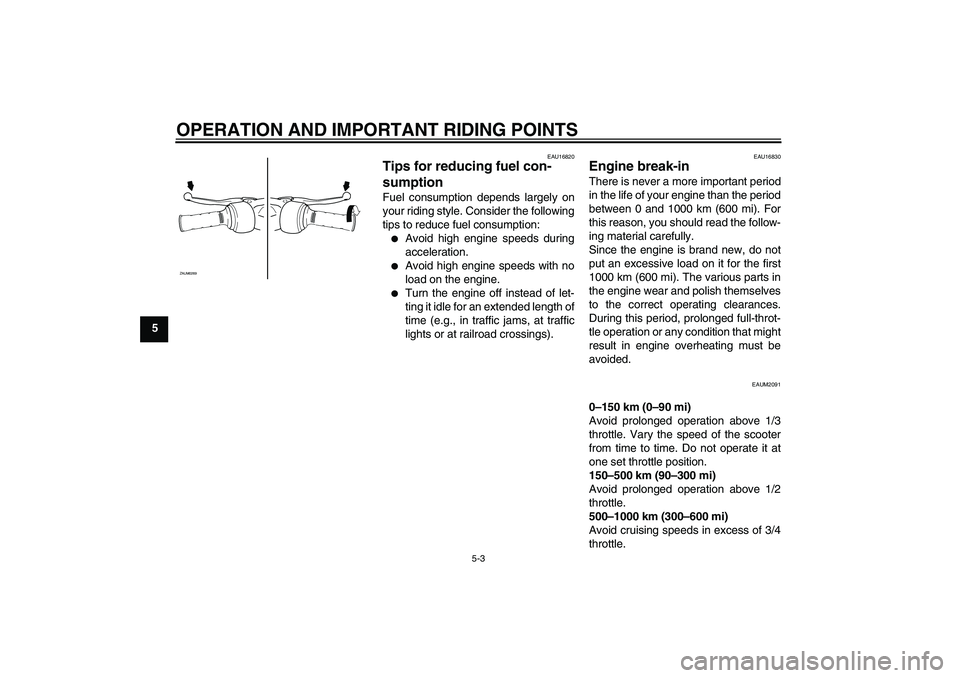Page 15 of 68

INSTRUMENT AND CONTROL FUNCTIONS
3-2
3
EAU11003
Indicator and warning lights
EAU11020
Turn signal indicator light“”
This indicator light flashes when the
turn signal switch is pushed to the left or
right.
EAU11080
High beam indicator light“”
This indicator light comes on when the
high beam of the headlight is switched
on.
EAU11181
Oil level warning light“”
This warning light comes on when the
key is in the“” position or if the oil lev-
el in the 2-stroke engine oil tank is low
during operation. If the warning light
comes on during operation, stop imme-
diately and fill the oil tank with Ya-
malube 2 or equivalent 2-stroke engine
oil of either JASO grade “FC” or ISO
grades “EG-C” or “EG-D”. The warning
light should go off after the 2-stroke en-
gine oil tank has been refilled.TIPIf the warning light does not come on
when the key is in the“” position or
does not go off after the 2-stroke en-
gine oil tank has been refilled, have a
Yamaha dealer check the electrical cir-cuit.NOTICE
ECA16291
Do not operate the vehicle until you
know that the engine oil level is suf-ficient.
EAU11433
Coolant temperature warning
light“”
This warning light comes on if the en-
gine overheats. If this occurs, stop the
engine immediately and allow the en-
gine to cool.NOTICE
ECA10021
Do not continue to operate the en-gine if it is overheating.TIP�
For radiator-fan-equipped vehi-
cles, the radiator fan(s) automati-
cally switch on or off according to
the coolant temperature in the ra-
diator.
1. Turn signal indicator light“”
2. High beam indicator light“”
3. Oil level warning light“”
TEMP
123
ZAUM0254
1. Coolant temperature warning light“”
TEMP
Km / h
E1/2
F
1
ZAUM0255
U3C6E1E0.book Page 2 Friday, August 8, 2008 10:09 AM
Page 30 of 68

OPERATION AND IMPORTANT RIDING POINTS
5-3
5
EAU16820
Tips for reducing fuel con-
sumption Fuel consumption depends largely on
your riding style. Consider the following
tips to reduce fuel consumption:�
Avoid high engine speeds during
acceleration.
�
Avoid high engine speeds with no
load on the engine.
�
Turn the engine off instead of let-
ting it idle for an extended length of
time (e.g., in traffic jams, at traffic
lights or at railroad crossings).
EAU16830
Engine break-in There is never a more important period
in the life of your engine than the period
between 0 and 1000 km (600 mi). For
this reason, you should read the follow-
ing material carefully.
Since the engine is brand new, do not
put an excessive load on it for the first
1000 km (600 mi). The various parts in
the engine wear and polish themselves
to the correct operating clearances.
During this period, prolonged full-throt-
tle operation or any condition that might
result in engine overheating must be
avoided.
EAUM2091
0–150 km (0–90 mi)
Avoid prolonged operation above 1/3
throttle. Vary the speed of the scooter
from time to time. Do not operate it at
one set throttle position.
150–500 km (90–300 mi)
Avoid prolonged operation above 1/2
throttle.
500–1000 km (300–600 mi)
Avoid cruising speeds in excess of 3/4
throttle.
ZAUM0269
U3C6E1E0.book Page 3 Friday, August 8, 2008 10:09 AM
Page 56 of 68

PERIODIC MAINTENANCE AND ADJUSTMENT
6-25
6Engine overheating
WARNING
EWA10400
�
Do not remove the radiator cap when the engine and radiator are hot. Scalding hot fluid and steam may be
blown out under pressure, which could cause serious injury. Be sure to wait until the engine has cooled.
�
After removing the radiator cap retaining bolt, place a thick rag, like a towel, over the radiator cap, and then
slowly rotate the cap counterclockwise to the detent to allow any residual pressure to escape. When the hissingsound has stopped, press down on the cap while turning it counterclockwise, and then remove the cap.
TIPIf coolant is not available, tap water can be temporarily used instead, provided that it is changed to the recommended coolantas soon as possible.
Wait until the
engine has cooled.
Check the coolant level in the
reservoir and radiator.
The coolant level
is OK.The coolant level is low.
Check the cooling system
for leakage.
Have a Yamaha dealer checkand repair the cooling system.Add coolant. (See TIP.)
Start the engine. If the engine overheats again,
have a
Yamaha dealer check
and repair the cooling system.
There is
leakage.
There is
no leakage.
U3C6E1E0.book Page 25 Friday, August 8, 2008 10:09 AM